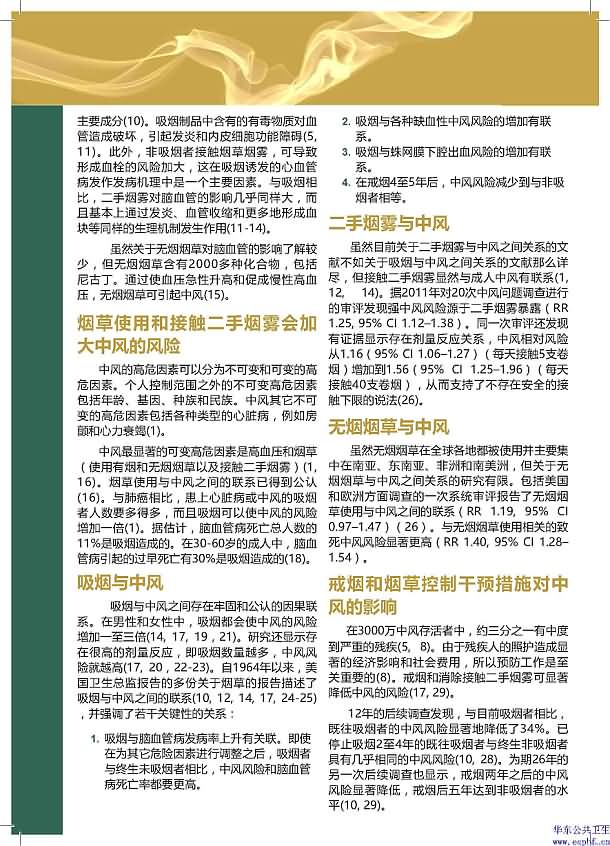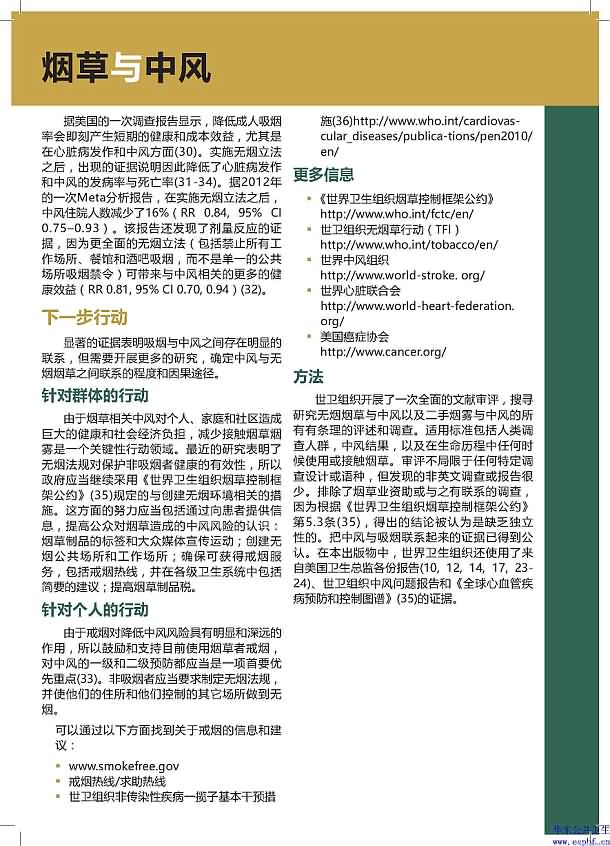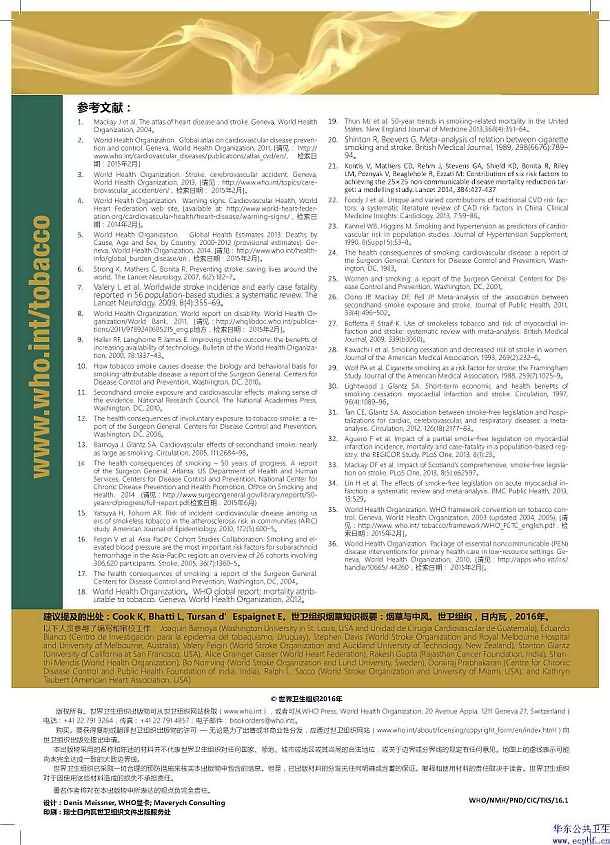



▪烟草使用是脑血管疾病的一种可避免的重大高危因素。
▪所有65岁以下的中风死亡病例中有五分之二与吸烟有联系。
▪接触二手烟雾和使用无烟烟草也会加大中风的风险。
▪戒烟之后4到5年,原吸烟者中风的风险与终生非吸烟者的风险几乎相同。
▪各国政府应当积极实施和执行《世界卫生组织烟草控制框架公约》的措施,尤其是无烟环境法律 和系统地提供戒烟服务。
烟草的定义
有烟烟草制品:“用烟草生产或产生的供人类消费的任何制品”。例子包括经加工的卷烟、自制卷烟、雪茄、水烟、丁香烟和比迪烟。
无烟烟草:由切制、碾磨、粉状的烟草或烟叶构成并意图放在口腔或鼻腔内使用的任何制品。例子包括gutka嚼烟、mishri烟和口含烟。
二手烟雾:吸烟者呼出的“主流”烟雾与卷烟及其它烟草制品燃烧时释放到环境中的“侧流”烟雾合并产生的烟雾。“被动吸烟”或“非自愿吸烟”等词语也常常被用来描述接触二手烟雾。
什么是中风?
当脑血管闭塞(缺血性中风)或者当脑血管破裂(出血性中风),就会发生中风,即脑血管病发作(1-4)。中风,或者脑血管病急性发作,常常被当作与心脏病发作相对等的脑部疾病(1,2)。
中风的先兆症状可包括(3,4):
▪脸部、手臂或腿部突然发麻或无力,尤其是在躯体单侧;
▪突然神志不清,语言不利或理解有困难;
▪单侧或双侧视力突然出现问题;
▪突然行走困难,头晕,丧失平衡或协调能力;
▪突然出现未知原因的严重头痛。
中风的严重程度取决于大脑受影响的部位以及闭塞的程度。中风有很高的死亡风险,并且甚至有更高的残疾风险。存活者可能会丧失视觉、语言能力或发生瘫痪。事实上,约三分之二的存活者出现显著的身体、心理和/或行为问题,其日常活动需要得到帮助(1)。
问题的严重性
在全球,中风是第二大死亡原因,也是第六大最常见的残疾原因(5)。每年约有1500万人有生第一次发生中风,其中三分之一,即约660万人,造成死亡(350万女性和310万男性)(1, 5)。就过早死亡和丧失的寿命年数而言,中风在低收入和中等收入国家比在高收入国家产生的问题更大。81%以上的中风死亡病例发生在低收入和中等收入国家(4,5);在这些国家,中风造成过早死亡的比率在70岁以下的中风死亡病例中高达94% (6)。
全世界目前有3300万中风存活者(7),其中1200多万人患有永久性的中度至重度残疾(8)。
随着年龄增长,中风变得越来越常见。虽然多数高收入国家已出现人口老龄化,但中风的整体发病率在其中有些国家正在下降,这是部分由于吸烟水平的降低(1)。随着低收入和中等收入国家人口老龄化程度和烟草使用流行率的增长,这些国家的中风患者人数预计将大量增多。因此,这些国家将面临与中风相关的残疾高负担造成的高额卫生和社会费用(7)。
即便有最先进的医学技术,60%的中风患者也会死亡或形成永久性残疾(9)。中风造成的残疾一般包括永久性瘫痪,可能需要大量帮助才能完成日常活动,而这一任务通常由家庭照护人员无偿承担。
烟草使用对中风的病理生理学影响
吸烟通过各种途径促成中风。尼古丁、一氧化碳和氧化性气体是可以引起中风的烟草烟雾主要成分(10)。吸烟制品中含有的有毒物质对血管造成破坏,引起发炎和内皮细胞功能障碍(5, 11)。此外,非吸烟者接触烟草烟雾,可导致形成血栓的风险加大,这在吸烟诱发的心血管病发作发病机理中是一个主要因素。与吸烟相比,二手烟雾对脑血管的影响几乎同样大,而且基本上通过发炎、血管收缩和更多地形成血块等同样的生理机制发生作用(11-14)。
虽然关于无烟烟草对脑血管的影响了解较少,但无烟烟草含有2000多种化合物,包括尼古丁。通过使血压急性升高和促成慢性高血压,无烟烟草可引起中风(15)。
烟草使用和接触二手烟雾会加大中风的风险
中风的高危因素可以分为不可变和可变的高危因素。个人控制范围之外的不可变高危因素包括年龄、基因、种族和民族。中风其它不可变的高危因素包括各种类型的心脏病,例如房颤和心力衰竭(1)。
中风最显著的可变高危因素是高血压和烟草(使用有烟和无烟烟草以及接触二手烟雾)(1, 16)。烟草使用与中风之间的联系已得到公认(16)。与肺癌相比,患上心脏病或中风的吸烟者人数要多得多,而且吸烟可以使中风的风险增加一倍(1)。据估计,脑血管病死亡总人数的11%是吸烟造成的。在30-60岁的成人中,脑血管病引起的过早死亡有30%是吸烟造成的(18)。
吸烟与中风
吸烟与中风之间存在牢固和公认的因果联系。在男性和女性中,吸烟都会使中风的风险增加一至三倍(14, 17, 19,21)。研究还显示存在很高的剂量反应,即吸烟数量越多,中风风险就越高(17, 20,22-23)。自1964年以来,美国卫生总监报告的多份关于烟草的报告描述了吸烟与中风之间的联系(10, 12, 14, 17, 24-25),并强调了若干关键性的关系:
1.吸烟与脑血管病发病率上升有关联。即使在为其它危险因素进行调整之后,吸烟者与终生未吸烟者相比,中风风险和脑血管病死亡率都要更高。
2.吸烟与各种缺血性中风风险的增加有联系。
3.吸烟与蛛网膜下腔出血风险的增加有联系。
4.在戒烟4至5年后,中风风险减少到与非吸烟者相等。
二手烟雾与中风
虽然目前关于二手烟雾与中风之间关系的文献不如关于吸烟与中风之间关系的文献那么详尽,但接触二手烟雾显然与成人中风有联系(1, 12, 14)。据2011年对20次中风问题调查进行的审评发现强中风风险源于二手烟雾暴露(RR 1.25, 95% CI 1.12–1.38)。同一次审评还发现有证据显示存在剂量反应关系,中风相对风险从1.16(95% CI 1.06–1.27)(每天接触5支卷烟)增加到1.56(95% CI 1.25–1.96)(每天接触40支卷烟),从而支持了不存在安全的接触下限的说法(26)。
无烟烟草与中风
虽然无烟烟草在全球各地都被使用并主要集中在南亚、东南亚、非洲和南美洲,但关于无烟烟草与中风之间关系的研究有限。包括美国和欧洲方面调查的一次系统审评报告了无烟烟草使用与中风之间的联系(RR 1.19, 95% CI 0.97–1.47)(26)。与无烟烟草使用相关的致死中风风险显著更高(RR 1.40, 95% CI 1.28–1.54)。
戒烟和烟草控制干预措施对中风的影响
在3000万中风存活者中,约三分之一有中度到严重的残疾(5, 8)。由于残疾人的照护造成显著的经济影响和社会费用,所以预防工作是至关重要的(8)。戒烟和消除接触二手烟雾可显著降低中风的风险(17, 29)。
12年的后续调查发现,与目前吸烟者相比,既往吸烟者的中风风险显著地降低了34%。已停止吸烟2至4年的既往吸烟者与终生非吸烟者具有几乎相同的中风风险(10, 28)。为期26年的另一次后续调查也显示,戒烟两年之后的中风风险显著降低,戒烟后五年达到非吸烟者的水平(10, 29)。
据美国的一次调查报告显示,降低成人吸烟 率会即刻产生短期的健康和成本效益,尤其是在心脏病发作和中风方面(30)。实施无烟立法之后,出现的证据说明因此降低了心脏病发作和中风的发病率与死亡率(31-34)。据2012年的一次Meta分析报告,在实施无烟立法之后,中风住院人数减少了16%(RR 0.84, 95% CI 0.75–0.93)。该报告还发现了剂量反应的证据,因为更全面的无烟立法(包括禁止所有工作场所、餐馆和酒吧吸烟,而不是单一的公共场所吸烟禁令)可带来与中风相关的更多的健康效益(RR 0.81, 95% CI 0.70, 0.94)(32)。
下一步行动
显著的证据表明吸烟与中风之间存在明显的联系,但需要开展更多的研究,确定中风与无烟烟草之间联系的程度和因果途径。
针对群体的行动
由于烟草相关中风对个人、家庭和社区造成巨大的健康和社会经济负担,减少接触烟草烟雾是一个关键性行动领域。最近的研究表明了无烟法规对保护非吸烟者健康的有效性,所以政府应当继续采用《世界卫生组织烟草控制框架公约》(35)规定的与创建无烟环境相关的措施。这方面的努力应当包括通过向患者提供信息,提高公众对烟草造成的中风风险的认识:烟草制品的标签和大众媒体宣传运动;创建无烟公共场所和工作场所;确保可获得戒烟服务,包括戒烟热线,并在各级卫生系统中包括简要的建议;提高烟草制品税。
针对个人的行动
由于戒烟对降低中风风险具有明显和深远的作用,所以鼓励和支持目前使用烟草者戒烟,对中风的一级和二级预防都应当是一项首要优先重点(33)。非吸烟者应当要求制定无烟法规,并使他们的住所和他们控制的其它场所做到无烟。
可以通过以下方面找到关于戒烟的信息和建议:
▪www.smokefree.gov
▪戒烟热线/求助热线
▪世卫组织非传染性疾病一揽子基本干预措
施(36)http://www.who.int/cardiovascular_diseases/publica-tions/pen2010/en/
更多信息
▪《世界卫生组织烟草控制框架公约》
http://www.who.int/fctc/en/
▪世卫组织无烟草行动(TFI)
http://www.who.int/tobacco/en/
▪世界中风组织
http://www.world-stroke. org/
▪世界心脏联合会
http://www.world-heart-federation. org/
▪美国癌症协会
http://www.cancer.org/
方法
世卫组织开展了一次全面的文献审评,搜寻研究无烟烟草与中风以及二手烟雾与中风的所有有条理的评述和调查。适用标准包括人类调查人群,中风结果,以及在生命历程中任何时候使用或接触烟草。审评不局限于任何特定调查设计或语种,但发现的非英文调查或报告很少。排除了烟草业资助或与之有联系的调查,因为根据《世界卫生组织烟草控制框架公约》第5.3条(35),得出的结论被认为是缺乏独立性的。把中风与吸烟联系起来的证据已得到公认。在本出版物中,世界卫生组织还使用了来自美国卫生总监各份报告(10, 12, 14, 17, 23-24)、世卫组织中风问题报告和《全球心血管疾病预防和控制图谱》(35)的证据。
参考文献
1. Mackay J et al. The atlas of heart disease and stroke. Geneva, World Health Organization, 2004。
2. World Health Organization. Global atlas on cardiovascular disease prevention and control. Geneva, World Health Organization, 2011, [请见: http://www.who.int/cardiovascular_diseases/publications/atlas_cvd/en/, 检索日期:2015年2月].
3. World Health Organization. Stroke, cerebrovascular accident. Geneva, World Health Organization, 2013, [请见:http://www.who.int/topics/cerebrovascular_accident/en/,检索日期: 2015年2月]。
4. World Health Organization. Warning signs. Cardiovascular Health, World Heart Federation web site, [available at: http://www.world-heart-federation.org/cardiovascular-health/heart-disease/warning-signs/,检索日期:2014年2月]。
5. World Health Organization. Global Health Estimates 2013: Deaths by Cause, Age and Sex, by Country, 2000-2012 (provisional estimates). Geneva, World Health Organization, 2014. [请见:http://www.who.int/healthinfo/global_burden_disease/en,检索日期:2015年2月]。
6. Strong K, Mathers C, Bonita R. Preventing stroke: saving lives around the world. The Lancet Neurology, 2007, 6(2):182–7。
7. Valery L et al. Worldwide stroke incidence and early case fatality reported in 56 population-based studies: a systematic review. The Lancet Neurology, 2009, 8(4):355–69。
8. World Health Organization. World report on disability. World Health Organization/World Bank, 2011, [请见:http://whqlibdoc.who.int/publications/2011/9789240685215_eng.p地方,检索日期: 2015年2月]。
9. Heller RF, Langhorne P, James E. Improving stroke outcome: the benefits of increasing availability of technology. Bulletin of the World Health Organization, 2000, 78:1337–43。
10. How tobacco smoke causes disease: the biology and behavioral basis for smoking-attributable disease: a report of the Surgeon General. Centers for Disease Control and Prevention, Washington, DC, 2010。
11. Secondhand smoke exposure and cardiovascular effects: making sense of the evidence. National Research Council, The National Academies Press, Washington, DC, 2010。
12. The health consequences of involuntary exposure to tobacco smoke: a re- port of the Surgeon General. Centers for Disease Control and Prevention, Washington, DC, 2006。
13. Barnoya J, Glantz SA. Cardiovascular effects of secondhand smoke: nearly as large as smoking. Circulation, 2005, 111:2684–98。
14. The health consequences of smoking – 50 years of progress. A report of the Surgeon General. Atlanta: US Department of Health and Human Services, Centers for Disease Control and Prevention, National Center for Chronic Disease Prevention and Health Promotion, Office on Smoking and Health; 2014 (请见:http://www.surgeongeneral.gov/library/reports/50-years-ofprogress/full-report.pdf,检索日期:2015年6月)
15. Yatsuya H, Folsom AR. Risk of incident cardiovascular disease among us ers of smokeless tobacco in the atherosclerosis risk in communities (ARIC) study. American Journal of Epidemiology, 2010, 172(5):600–5。
16. Feigin V et al. Asia Pacific Cohort Studies Collaboration. Smoking and elevated blood pressure are the most important risk factors for subarachnoid hemorrhage in the Asia-Pacific region: an overview of 26 cohorts involving 306,620 participants. Stroke, 2005, 36(7):1360–5。
17. The health consequences of smoking: a report of the Surgeon General. Centers for Disease Control and Prevention, Washington, DC, 2004。
18. World Health Organization。WHO global report: mortality attributable to tobacco. Geneva, World Health Organization, 2012。
19. Thun MJ et al. 50-year trends in smoking-related mortality in the United States. New England Journal of Medicine 2013;368(4):351–64。
20. Shinton R, Beevers G. Meta-analysis of relation between cigarette smoking and stroke. British Medical Journal, 1989, 298(6676):789–94。
21. Kontis V, Mathers CD, Rehm J, Stevens GA, Shield KD, Bonita R, Riley LM, Poznyak V, Beaglehole R, Ezzati M: Contribution of six risk factors to achieving the 25 × 25 non-communicable disease mortality reduction target: a modelling study. Lancet 2014, 384:427-437
22. Foody J et al. Unique and varied contributions of traditional CVD risk factors: a systematic literature review of CAD risk factors in China. Clinical Medicine Insights: Cardiology, 2013, 7:59–86。
23. Kannel WB, Higgins M. Smoking and hypertension as predictors of cardiovascular risk in population studies. Journal of Hypertension Supplement, 1990, 8(Suppl 5):S3–8。
24. The health consequences of smoking: cardiovascular disease: a report of the Surgeon General. Centers for Disease Control and Prevention, Washington, DC, 1983。
25. Women and smoking: a report of the Surgeon General. Centers for Dis-ease Control and Prevention, Washington, DC, 2001。
26. Oono IP, Mackay DF, Pell JP. Meta-analysis of the association between secondhand smoke exposure and stroke. Journal of Public Health, 2011, 33(4):496–502。
27. Boffetta P, Straif K. Use of smokeless tobacco and risk of myocardial infarction and stroke: systematic review with meta-analysis. British Medical Journal, 2009, 339(b3060)。
28. Kawachi I et al. Smoking cessation and decreased risk of stroke in women. Journal of the American Medical Association, 1993, 269(2):232–6。
29. Wolf PA et al. Cigarette smoking as a risk factor for stroke: the Framingham Study. Journal of the American Medical Association, 1988, 259(7):1025–9。
30. Lightwood J, Glantz SA. Short-term economic and health benefits of smoking cessation: myocardial infarction and stroke. Circulation, 1997, 96(4):1089–96。
31. Tan CE, Glantz SA. Association between smoke-free legislation and hospitalizations for cardiac, cerebrovascular, and respiratory diseases: a meta-analysis. Circulation, 2012, 126(18):2177–83。
32. Aguero F et al. Impact of a partial smoke-free legislation on myocardial infarction incidence, mortality and case-fatality in a population-based registry: the REGICOR Study. PLoS One, 2013, 8(1):23。
33. Mackay DF et al. Impact of Scotland’s comprehensive, smoke-free legislation on stroke. PLoS One, 2013, 8(5):e62597。
34. Lin H et al. The effects of smoke-free legislation on acute myocardial infarction: a systematic review and meta-analysis. BMC Public Health, 2013, 13:529。
35. World Health Organization. WHO framework convention on tobacco control. Geneva, World Health Organization, 2003 (updated 2004, 2005), [请见:http://www. who.int/ tobacco/framework/WHO_FCTC_english.pdf,检索日期:2015年2月]。
36. World Health Organization. Package of essential noncommunicable (PEN) disease interventions for primary health care in low-resource settings. Geneva, World Health Organization, 2010, [请见:http://apps.who.int/iris/handle/10665/ 44260,检索日期: 2015年2月]。




